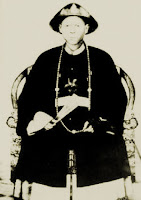 |
| Kuala Lumpur 1884 |
In 1857, Raja
Abdullah, a member of the Selangor Royal Family started opening up parts of the
Klang Valley to tin prospectors. With the rise of the tin extraction industry,
prospectors started pouring in to a new settlement on the banks of a “muddy
confluence” between the Gombak and Klang rivers – creating the early foundation
of the city (the city’s name comes from the word Kuala meaning – ‘junction’ or ‘estuary’
and Lumpur means – ‘muddy’).
 |
| Kapitan Yap Ah Loy |
As the new town kept growing, the fragile peace between many
of the interested parties did not last. A bitter rivalry between the triads and
civil war between the Selangor princess erupted over the tin, leading to bloody
feuds and wars. When Kapitan Yap Ah Loy, the third leader of the Chinese
community was appointed by British, peace was again restored and under his
competent leadership the sleepy mining town boomed into a commercial trading hub
of every high importance.
In 1880, Kuala
Lumpur was made the capital of Selangor due to large part to Kapitan Yap Ah Loy’s
success and efficiency in maintaining the peace and a system of law and order. During
another furious feud – Kuala Lumpur was burnt down and Kapitan Yap decided this
time to rebuild the town using bricks and tiles, replacing the older dangerous atap or wooden houses. Also at this time
Sir Frank Swettenham was appointed the Resident – General of Selangor.
 |
| Sir Frank Swettenham |
After Kapitan Yap’s death in 1885, Sir Frank Swettenham oversaw the growth of Kuala Lumpur as
the town continued to prosper. With the completion of the first railway
connecting the town to Port Klang in 1886,
Kuala Lumpur’s growth was further boosted.
In 1896 the
Federated Malay Sates (FMS) which at the time only consisted of four states was
incorporated and with Swettenham as the Resident-General, Kuala Lumpur was
chosen to be the capital and the town continued to evolve becoming the classic
epitome of British colonialism, with sharply uniformed white officers
administrating the FMS Unsurprisingly with the oppression of British
imperialism, local nationalists were burning with their own dreams of
independence.
At the stroke of midnight on 31August 1957, amidst tens of thousands of people, the British
Union Jack – which had stood waving in front of the Selangor Club, was finally
lowered on Malaysian soil for the last time and Malaysia’s independence was
ushered in Malaysia’s independence was declared by the first Prime Minister,
Tunku Abdul Rahman Putra Al-Haj, in Stadium Merdeka, now a UNESCO World
Heritage Site.
With the nation’s newfound independence, Kuala Lumpur began
moving towards greatest transformation But, once again, as in the troubled past
things came to halt when violent and bloody civil unrest exploded across the
city as a result of racial tensions. The unrest sparked a state of emergency
which continued for the next two years. These tensions finally subsided again
after negotiations were made to bring the nation’s people together as one.
Eventually, Kuala Lumpur was conferred city status on February 1st 1972 and in 1974 Kuala Lumpur was declared a
Federal Territory. During the last few decades, Kuala Lumpur has been witness
to incredible social and economic growth – with significant increases to the
population and major development throughout the city. Today, Kuala Lumpur‘s
progress is perhaps best measured by the PETRONAS Twin Towers – one of the
world’s tallest buildings standing admirably among the Kuala Lumpur skyline.
Reference: http://www.2malaysia.com/kualalumpur/history.htm
Reference: http://www.2malaysia.com/kualalumpur/history.htm


No comments:
Post a Comment